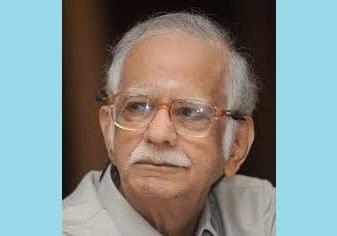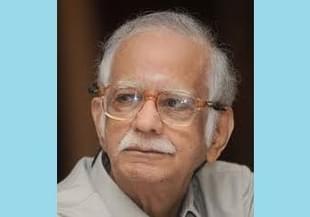Culture
Dr Iravatham Mahadevan: A Tribute To An Indus Intellectual
Aravindan Neelakandan
Nov 27, 2018, 01:36 PM | Updated 01:36 PM IST
Save & read from anywhere!
Bookmark stories for easy access on any device or the Swarajya app.


The story is apocryphal. A young Indian Administrative Service officer was face to face with the prime minister of India. And the prime minister questioned his association with the Rashtriya Swayamsevak Sangh (RSS). Was he a member? The young officer answered the PM looking straight into his eyes that if he were to remove him from service just because of his association with the RSS, he would lose an honest officer. The prime minister was Jawaharlal Nehru and the officer was Iravatham Mahadevan, who served as assistant financial adviser in the Ministry of Commerce and Industry from 1958 to 1961. I do not know if this story is true but I do know that Mahadevan indeed had been a swayamsevak in his early days and was an admirer of Guruji Golwalkar. In 2006, when Tamil Nadu RSS brought out a centenary volume on Golwalkar, Mahadevan contributed to it - reminiscing Golwalkar’s greatness and simplicity.
Dr Mahadevan is known for taking a stand in his study of the Harappan script - a stand many thought had close similarities with that of the Dravidianists. However, his stand was more nuanced though leaning towards the Indo-Aryan-migration and the native Dravidian. In an interview to Harappa.com he explained this in detail:
There are no Aryans in India, nor are there any Dravidians. Those who talk about Dravidians in the political sense, I do not agree with them at all. There are no Dravidian people or Aryan people - just like both Pakistanis and Indians are racially very similar. We are both the product of a very long period of intermarriage, there have been migrations. You cannot now racially segregate any element of the Indian population. Thus there is no sense in saying that the people in Tamil Nadu are the inheritors of the Indus Valley culture. You could very well say that people living in Harappa or Mohenjo-daro today are even more likely to be the inheritors of that civilisation. In fact, I plough a somewhat lonely furrow in this. I often say that if the key to the Indus script linguistically is Dravidian, then culturally the key to the Indus script is Vedic. What I mean is that the cultural traits of the Indus Valley civilisation are likely to have been absorbed by the successor Indo-Aryan civilisation in Punjab and Sindh, and that the civilisation in the far south would have changed out of recognition. In any case, the present South Indian civilisation is already the product of both Indo-Aryan and Dravidian cultures, and the language itself is completely mixed up with both elements. Tamil alone retains most of the earlier Dravidian linguistic structure.
How did Dr Mahadevan corroborate the vedic cultural nature of Harappan civilisation? He identifies the ‘cult object’ before the famous Unicorn seal as the Soma filter. Iravatham Mahadevan claims that the central aspect of vedic culture, namely Soma ritual was Dravidian, which was borrowed and integrated by the incoming Aryans. It is not hard to see what Mahadevan does to explain the vedic nature of Harappan civilisation in the Aryan-Dravidian binary scenario, is to create the notorious epicycle equivalent in Harappan studies. What is actually important is his application of the most sacred aspect of Rig Vedic knowledge to the most prominent aspect of Harappan culture. Much to the discomfort of many Dravidianists, Dr Mahadevan’s study of the terminal signs in Harappan seals suggested a Varna-like structure existing in the Harappan society.
Dr Mahadevan exposed the dishonesty of the leftists in the Ayodhya issue. In a lecture given at Chennai in 1990, he pointed out that while the Jawaharlal Nehru University (JNU) worthies started their attack on Ram Janmabhoomi movement armed with the data from the archaeological studies of Dr B B Lal without naming him, they were strangely silent on his other major finding that a prior structure existed at the site of the Babri Masjid. Thus it was the JNU 'scholars' who were indulging in the 'political abuse of history'. (cited by Dr Elst, Ayodhya and After, 1991).
Archaeologist Dr K K Muhammed in his interview to Swarajya, reminisced how Iravatham Mahadevan was a ‘true liberal man’ who unlike the fundamentalists of JNU was committed to truth. It was he who urged Dr Muhammed the only Muslim archaeologist who had excavated Ayodhya to disclose the facts. Dr Muhammed revealed the facts of Lal’s excavations that revealed a structure beneath the Babri Masjid in the Indian Express two years prior to the 6 December karseva. Had the media publicised the truths unveiled by Mahadevan and Muhammed, a lot of tragedies in the form of post-6 December communal riots could have been avoided.
The proximity of Mahadevan to Dravidian hypothesis sometimes resulted in confrontation with the emerging neo-Hindutvaites of late 1990s. Mahadevan, who was awarded the Jawaharlal Nehru Fellowship in 1970, had come up with a hypothesis that the Harappan script is ‘a language which resembles South Dravidian (including Telugu) in general and Old Tamil in particular’. He earlier published Corpus of the Tamil-Brahmi Inscriptions in 1966. The Indus Script: Texts, Concordance and Tables, painstakingly created by him in 1977, is a major accomplishment and even today considered as the source-book for research on the subject.
Mahadevan and Hindutva writer Dr N S Rajaram entered into a bitter controversy in 2002-2003 over the interpretation of Harappan seals. Michael Witzel and Steve Farmer a team of Indophobic Indologists from Harvard University used the authority of Mahadevan to attack and demonise Rajaram and the entire Hindutva movement. In this, they were eagerly helped by a Maoist media establishment in Chennai’s Mount Road, following which the Witzel-Farmer duo did not spare even Mahadevan.
Farmer, was actively spearheading the hypothesis that the Harappan civilisation was rife with ignorance. Mahadevan was critical of this. Farmer did not hesitate to accuse Mahadevan of having distorted the Indus signs to look like language alphabets. In 2009, Mahadevan along with a team of scientists studied Harappan script using a mathematically rigorous method and established that the signs encoded a language. When the paper was published in Science, Farmer and Witzel attacked it, saying, ‘garbage in, garbage out’. That’s when Mahadevan realised that these people, particularly Farmer, was exhibiting “a consistently aggressive style”.
Dr Mahadevan’s is a life of honesty, simplicity, mostly academic rigour. That he was partial to Dravidian hypothesis did not stop him from using vedic literature to study the Harappan culture and symbols. Even when he was attacked by Neo-Hindutvaites and when he was surrounded by pseudo-secularists, he did not hesitate to acknowledge his RSS connection and admiration for Guruji Golwalkar. But for his encouragement, Dr Muhammed would not have written that letter exposing JNU academicians in 1990, which stands even today as a testimony to the way Marxist historians criminally thwarted an amicable solution and communal harmony.
Eighty-eight-year-old Dr Iravatham Mahadevan has passed away (26 November), but has left behind celebrated works on the Indus scripts and Tamil-Brahmi inscriptions that would inspire many more such rigorous pursuits.
Aravindan is a contributing editor at Swarajya.





